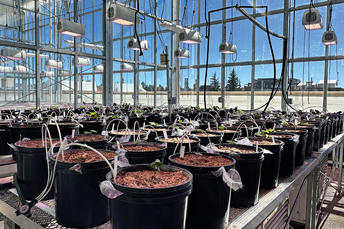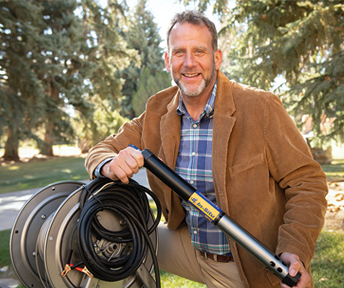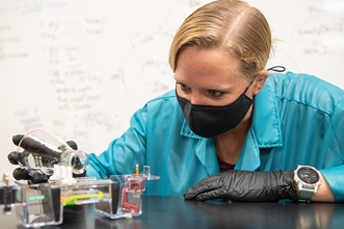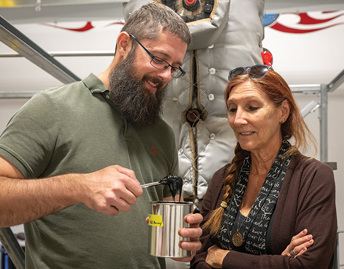
Contact Us
Institutional Communications
Bureau of Mines Building, Room 137
Laramie, WY 82071
Phone: (307) 766-2929
Email: cbaldwin@uwyo.edu
Aiding Industry
Published January 26, 2024

The new Plant Growth and Phenotyping Facility in the Science Initiative Building
offers 6,000-square-feet of high-tech greenhouses and laboratories. (Courtesy photo)
UW research and development helps support industries across the state.
By Micaela Myers
New Plant Growth and Phenotyping Facility
Last year, UW launched the Plant Growth and Phenotyping Facility, an innovative research center aimed at helping researchers and students better understand plant response to the environment.
Cutting-edge, highly applicable research requires fine regulation of environmental parameters, such as humidity, light, temperature and carbon dioxide to create the desired growing conditions. This UW core facility located in the new Science Initiative Building offers a 6,000-square-foot complex of fully automated greenhouses and two large walk-in chambers for tight environmental control, as well as adjacent laboratory spaces to support research activities. The presence of Facility Manager Michael Baldwin, a controlled environment agriculture specialist, ensured additional deployment of hydroponic and vertical growing systems at the facility to further students’ experiences in modern agriculture and help address research questions in this field.
As a part of the UW Science Initiative, the facility will enable interdisciplinary research and education to form a skilled workforce, strengthening Wyoming’s economy. The state’s Wyoming Innovation Partnership funded the facility’s phenotyping instrumentation, a system of cameras to monitor plant response to the environment, as part of a larger effort to boost controlled environment agriculture development in the state. The partnership also funds curriculum development for UW and community college students in this field.
“Nowadays, imaging phenotyping allows for high throughput — measuring a lot of plants in a very short time,” says facility Director Carmela Rosaria Guadagno. “For instance, you can monitor plant response to changing environmental factors, pests’ outbreaks, microbial interactions or nutritional imbalance, and answer relevant biological questions via images. Our facility is equipped to perform convergent research. Teams from plant sciences, botany, molecular biology, plus engineering and computer science students and other disciplines can efficiently collaborate here, working together to tackle pressing research problems related to plant-environment interactions.”
Visit www.uwyo.edu/science-initiative/plant-facility/index.html.
Wyoming’s CarbonSAFE Projects
Each year, human activities release more carbon dioxide (CO2) into the atmosphere than natural processes can remove, according to the National Oceanic and Atmospheric Administration. By doing so, we supercharge the natural greenhouse effect, causing global temperatures to rise. A variety of technologies can help combat this issue, including carbon capture and storage.
“Gov. Mark Gordon has challenged Wyoming to become net negative CO2,” says Fred McLaughlin, the director of the School of Energy Resources (SER) Center for Economic Geology Research. “You can’t do that without addressing a lot of carbon management challenges. The technology that is commercially proven and can reduce CO2 emissions is carbon capture and storage. The carbon came from underground, and we can put it back underground. Wyoming is a leader in this.”
The Wyoming CarbonSAFE Project, which stands for Carbon Storage Assurance Facility Enterprise, is one of 13 original carbon capture, utilization and storage project sites in the U.S. funded by the Department of Energy (DOE). The initial Wyoming project is located in Campbell County and will become the first permanent storage site for CO2 in the state, providing carbon management for coal-fired power plants. Recently, SER was awarded a second project under the CarbonSAFE program — the Sweetwater Carbon Storage Hub. Led by Center for Economic Geology Research Program Manager Zunsheng “John” Jiao, this project builds upon the lessons learned from the first project and is UW’s largest grant in history. The hub will provide carbon management options for the trona industry among other sources. A third project, the HERO Basalt Mineralization CarbonSAFE project is located in Oregon in a region that uses Wyoming natural gas, while a fourth project was recently announced in the Echo Springs area of south-central Wyoming.
“This is federal money coming into the state, and we do our best to spend it right here in these communities,” McLaughlin says. This includes millions of dollars in services, drilling wells and Wyoming-focused research, leading to jobs and revenue in Wyoming. The project also involves outreach, education and workforce development, including collaborating with community colleges to develop related curriculum. SER created a first-of-its-kind carbon capture, utilization and storage certificate for undergraduates in conjunction with the College of Engineering and Physical Sciences and the College of Business and has led public policy efforts so that the technology can be safely regulated.
McLaughlin finds the applied science aspects of this work especially rewarding: “You can really see the impacts and quantify the difference these projects are making.”

Director of the Center for Biogenic Natural Gas Research Michael Urynowicz shows
off well equipment that records data to help correlate parameters of renewable natural
gas production and carbon capture and storage.
Center for Biogenic Natural Gas Research and Cowboy Clean Fuels
The School of Energy Resources Center for Biogenic Natural Gas Research was created to provide groundbreaking research and development that adds value to Wyoming’s vast energy resources by keeping them viable in the energy economy of the future.
“The primary focus of the center is to develop technologies that enhance the production of biogas in deep geologic reservoirs, such as coal seams using indigenous microorganisms,” says Director Michael Urynowicz. “Engineering these vast subterranean systems for biogas production can also provide large-scale opportunities for carbon sequestration and the decarbonization of existing fossil fuel resources.”
Currently, the center’s researchers are working on a number of projects, including developing standard methods for differentiating between fossil-based natural gas and renewable natural gas using stable and unstable isotopes. Another project involves determining the carbon intensity associated with various hydrogen production methods.
“Hydrogen is often viewed as an important energy carrier in a future decarbonized world,” Urynowicz says. “Currently, most hydrogen is produced using the steam methane reformation process, which also releases large amounts of CO2 into the atmosphere. Researchers at the center are working to develop more innovative methods for hydrogen production.”
A spinoff company, Cowboy Clean Fuels, is using the center’s patented technology to sequester carbon and produce renewable natural gas from economically depleted coal-bed methane wells in Wyoming’s Powder River Basin.
“The Cowboy Clean Fuels process leverages the anaerobic microbial systems present in coal seams and the ability of the microorganisms to convert sugar beet molasses and other biomass-derived substrates into methane and CO2 while sequestering carbon,” Urynowicz explains. “The process starts with the direct capture of carbon dioxide from the atmosphere through photosynthesis during sugar beet production.”
The company takes the resulting molasses mixed with water and delivers it into the coal seam, where the indigenous microorganisms play a vital role in converting it into methane and CO2. When the reservoir is depressurized by pumping gas and water from the wells, the methane surfaces while the CO2 remains below. The coal’s high affinity to absorb CO2 results in a long-lived form of carbon capture. In addition, the methane is brought to market as renewable natural gas.
“When at full scale, our project is expected to produce over 700 million cubic feet of renewable natural gas annually, while also permanently sequestering approximately 180,000 metric tons of CO2 per year,” says Chairman and CEO Ryan Waddington. “That’s enough renewable natural gas to heat 10,000 typical U.S. homes for a year and the equivalent of taking 28,000 passenger vehicles off the road.”
This work helps preserve energy-related jobs and create new jobs. Furthermore, the patents held by UW generate royalties that provide support to students and the institution.

UW-Casper student Caitlyn Edwards prepares DNA samples for analysis.
Wyoming IDeA Networks for Biomedical Research Excellence
The Wyoming IDeA Networks for Biomedical Research Excellence Program, or Wyoming INBRE Program, is funded by the National Institutes for Health’s National Institute for General Medical Sciences and Institutional Development Award (IDeA) Program to help Wyoming build its biomedical research and education infrastructure — in partnership with the state’s community colleges.
“The grand goal of the INBRE program is to help states that need it build their biomedical research and education infrastructure so that they are competitive for research grants, can support the development of the biomedical technology sector of economies and can help students move into the biomedical workforce,” says Director Scott Seville.
INBRE’s strong community college partnerships over the past 20-plus years resulted in each college providing research-committed laboratories where students receive hands-on experience. INBRE purchases state-of-the-art equipment and trains the faculty.
“The resources in these labs are used to modernize the experiences students are having in their courses,” Seville says. This includes access to things such as DNA technology in biology labs. When students transfer to UW, they are eligible for transition awards that provide financial assistance and further research experiences.
INBRE also purchases needed research equipment for UW labs, supports UW researchers and students, and provides data science infrastructure and training to community colleges and UW, which is now critical for the large data generated by genomic, proteomic and metabolomic research. INBRE serves as the biomedical and biotech partner for the Wyoming Innovation Partnership and is involved in many other grants, programs and partnerships at UW and around the state.
Seville says, “There’s a real interest in how we can better serve the underserved populations, including the rural parts of our country like Wyoming, as well as opening up opportunities for young people to create jobs and businesses in our state and providing opportunities for our health-care professionals to engage in the biomedical research enterprise.”

Jeramie Adams of the Western Research Institute and Trina Igelsrud Pfeiffer of
the School of Energy Resources are working together to develop coal-based asphalt.
Coal-Based Asphalt
You’ve likely seen charcoal toothpaste and soap at the drugstore, but those products only scratch the surface when it comes to alternative uses for coal. UW’s School of Energy Resources Center for Carbon Capture and Conversion aims to find new alternative uses for Wyoming coal, including building materials recently used to create a demonstration house. The center also teamed up with Laramie’s Western Research Institute (WRI) to develop a coal-based asphalt.
“Coal-based asphalt has many benefits, such as a lower CO2 footprint due to lower emissions from extraction and transportation of Powder River Basin coal compared to conventional crude oil and the fact that a significant amount of CO2 can be stored in a coal-based pavement because of the biobased reactive solvents that are used to produce the product,” says Jeramie Adams, vice president of WRI’s RenuMAT group (Renewable Upcycling, Materials and Asphalt Technologies). “The product is being carefully developed to meet industry practices and performance standards so that it can be easily and safely applied, is cost effective, and will be a long-lasting and durable product in the field.”
This past summer, the asphalt was a featured product at a number of conferences, and UW’s researchers have received multiple requests from major roofing and paving companies for samples.
“There is a lot of support and excitement about a possible coal-based product with a lower CO2 footprint, especially considering that Powder River Basin coal is abundant, cheap and a domestic feedstock,” Adams says. These positive outcomes are leading to new funding opportunities.
Coal-based asphalt carries great economic potential. Adams says approximately 30 million tons of asphalt are used each year in North America, and 110 million tons are used globally.
“Our lab is working in tandem with WRI on scaling up the solvent extraction processing technology to meet the increased demand for sample testing from potential investors,” says Center for Carbon Capture and Conversion Director Trina Igelsrud Pfeiffer. “We have a lot of great industry partners in the basin as well as a potential host site adjacent to the mines for easy access to coal. At this stage, the field demonstration scale-up is entirely dependent on available funding but, with the coal-based asphalt being such a promising product on the downstream side, we hope there will be a lot of interest and investment in driving both projects toward commercialization.”
Outdoor Recreation and Tourism
Tourism is the second largest industry in Wyoming, generating $4.5 billion in 2022. What’s more, it’s the largest private employment sector in the state, employing over 33,000. To further support this industry and provide a trained workforce, UW’s Haub School of Environment and Natural Resources in partnership with the College of Business launched the outdoor recreation and tourism management bachelor’s degree program in 2018. Expanding this effort, the Wyoming Outdoor Recreation, Tourism and Hospitality (WORTH) Initiative was launched in 2022 with a focus on applied research, educational offerings, and extension and outreach.
The interdisciplinary degree program now boasts 80 enrolled students. Experiential learning plays a key role in their education, including senior capstone projects in partnership with state and federal agencies and businesses.
“Not only are students getting involved in things that are directly impactful and important to the state, but those projects can lead to future employment,” says WORTH Director Dan McCoy.
For example, in 2022, student groups worked on three major projects. For the Wyoming Office of Tourism, they completed tourism asset assessments for 14 counties looking at main attractions, hidden gems and local recommendations for recreational, cultural, lodging and food options. Other students worked with Visit Laramie researching a tourism ambassador training program to enhance front-line tourism and hospitality employee knowledge of Laramie history, culture, recreation and other attraction information. That project now benefits Albany County with an online Certified Destination Expert training program. The third project took place in Fremont County, where students worked with the Wind River Visitors Council to seek the Continental Divide Trail Gateway Community designation through the Continental Divide Trail Coalition for Lander and South Pass City. This designation ensures that gateway communities have the ability to support Continental Divide hikers.
“The work of students in this space helps elevate these partners and makes a difference in asset development for tourism and outdoor recreation,” McCoy says.
Wyoming Outdoor Recreation Manager Patrick Harrington has mentored these students and seen firsthand how their capstone projects benefit them and the state. “The students are getting hands-on experience with the skills it takes to be successful in this industry, and this couldn’t come at a better time for Wyoming,” he says. “As this field continues to grow, having a pipeline of knowledgeable workers will be critical to keep the industry moving forward.”
Contact Us
Institutional Communications
Bureau of Mines Building, Room 137
Laramie, WY 82071
Phone: (307) 766-2929
Email: cbaldwin@uwyo.edu


